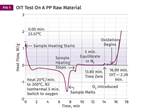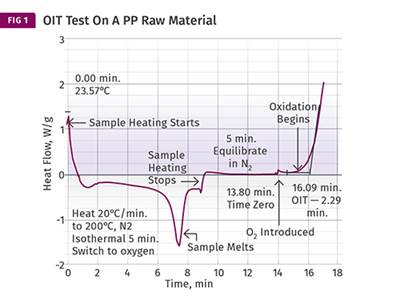Finding Root Causes of a Material Problem
Tools and methods for determining oxidative stability can be useful, but even more useful if constructed to yield the information you really need.
There is a tendency in our current manufacturing environment to drive investigations of non-conforming products to a root cause. The implication, if not the explicit presumption of such an endeavor, is that there is a single reason for a product failure. This approach misses the complex interaction that involves the material, processing, part design, and tooling.
Periodically, we see papers and articles that at some point assign root causes in these neat categories, stating for example that 40% of failures are due to poor design, 20% are due to poor material selection, etc. Usually these percentages are skewed according to the expertise or bias of the person or people performing the assessment. Designers will tend to blame designs (unless it is theirs) because they are attuned to the things that can go wrong in this area. People with specialization in materials will similarly point to deficiencies in this area because they know the details of what can go wrong.
But these types of analyses tend to reinforce the myth that failures fit neatly into these compartments with no influence from any of the other factors. This approach can also blind us to the multiple paths that potentially exist for correcting a problem and can send us down a much more costly and time-consuming path to a solution than is necessary.
Consider, as an example, a molded cover that was designed to protect an assembly used in an outdoor environment. Several key requirements are associated with this application. These include good UV stability and good low-temperature impact resistance. In addition, because the housing is close to live electrical components, there was an additional requirement that the material must have a flammability rating of at least UL 94V-2.
Outdoor weathering is a challenging requirement for most polymers. However, significant protection can be provided by carbon black, and the addition of a suitable UV stabilizer can enhance protection of the part surface and extend the life of a component substantially. Ensuring the use of a material with
a UL flammability rating is a matter of following the regulatory guidelines. The low-temperature impact requirement was codified into a test that involved dropping a 2-in.-diam. steel ball onto a specific location on the part from a height of 4 ft while the part was at a temperature of -35 C (-31 F). This was the test that stopped the product-development process in its tracks. The part failed the low-temperature impact test, exhibiting a brittle fracture and leaving a hole in the part that would allow a user to contact the electrical components within the housing.
The initial conclusion from this type of event can take any number of directions. Often the molder gets the blame for the failure and the discussion centers on the process parameters. However, in this case the immediate conclusion on the part of the customer was that the wrong material had been selected and a tougher compound was required. The material initially selected was a polypropylene. That choice was based on the perception that the material was ductile, which it was at room temperature. However, at the required temperature for the impact test it did not perform as desired.
Finding a PP material with good low-temperature ductility is not impossible, but it is challenging. PP homopolymers are typically brittle at temperatures below 0 C (32 F) even if the average molecular weight of the product is relatively high. Copolymers have better low-temperature impact resistance, and with the right formulation it is conceivable that a product could be engineered to fulfill the impact requirements. The challenge was much greater in this case because of the need to incorporate a flame retardant into the material to meet the UL 94V-2 requirement.
Chemically, PP is a hydrocarbon and therefore burns readily unless some modifications are made to the formulation. A variety of substances can be added to PP in order to achieve some level of flame-retardant properties. But these substances need to be added at significant levels and they frequently reduce toughness. So the prospects for finding a material in the PP family that could fulfill the complete list of requirements was not good.
However, a closer look at the mold showed that this was far from just a material-selection issue. The part had been gated in such a way that a weld line formed in the same area where the impact test was conducted. Many years ago, I went to a Glenn Beall design seminar and one of the slides that really stuck with me was the one that advised against allowing weld lines to develop in areas of high stress.
Weld lines are unlikely to be as strong as the parent material. The strength that can be obtained at a weld line is partly a matter of the material being molded and partly a matter of processing conditions. Under optimal molding conditions, amorphous polymers such as polycarbonate and polysulfone can produce relatively strong weld lines. Semi-crystalline materials such as PP and nylon tend to produce weaker weld lines because of the rapid transition that they undergo as they cool from molten to solid. Fillers tend to erode weld-line strength to an even greater degree because they do not melt with the polymer and therefore they do not form a good bond when the flow fronts meet. They also displace the polymer that does fuse. Even though flame retardants are not thought of as fillers, they essentially influence the properties of the compound in a manner similar to common fillers such as talc or glass. And it can require a significant amount of flame retardant to keep PP from burning.
Processing conditions also affect weld-line integrity. Mold-filling rates, melt and mold temperatures, and pack pressures and times can all influence the integrity of a weld line. The angle at which the flow fronts meet when the weld forms will also have an effect on the strength of the material. But even assuming optimal processing conditions, it is improbable that a weld line in a flame-retardant PP will have more than 70% of the integrity of the surrounding material. Once the mold-design consideration of gate location is included in the problem-solving exercise, the simple conclusion that this is a “material problem” is not so satisfactory.
And there was a third problem. When the part was analyzed in the lab, it was found that the material had been contaminated with nylon 66 at a level of about 5%. Very few polymers mix well. Most of the time, contamination results in delamination, cosmetic problems, and reduced performance. In this case there was the additional problem that typical melt temperatures used to process PP are below the melting point of nylon 66. So there will be evidence of unmelted material within the part. While strictly speaking this is a material problem, it is not a reflection of the inherent ability of the selected material to perform. Instead it is a material-handling problem, which is the responsibility of the processor.
So when diving into a problem-solving exercise, it is useful to keep in mind that there is rarely one cause. More often than not, multiple influences converge to create failures. They all need to be captured in order to come up with the most efficient and lowest cost solution to the problem.
ABOUT THE AUTHOR
Mike Sepe is an independent, global materials and processing consultant whose company, Michael P. Sepe, LLC, is based in Sedona, Ariz. He has 40 years of experience in the plastics industry and assists clients with material selection, designing for manufacturability, process optimization, troubleshooting, and failure analysis. Contact: (928) 203-0408 mike@thematerialanalyst.com.
Related Content
The Effects of Temperature
The polymers we work with follow the same principles as the body: the hotter the environment becomes, the less performance we can expect.
Read MoreResin Prices Still Dropping
This downward trajectory is expected to continue, primarily due to slowed demand, lower feedstock costs and adequate-to-ample supplies.
Read MoreThe Strain Rate Effect
The rate of loading for a plastic material is a key component of how we perceive its performance.
Read MoreCommodity Resin Prices Flat to Lower
Major price correction looms for PP, and lower prices are projected for PE, PS, PVC and PET.
Read MoreRead Next
The Importance of Oxidative Stability In Polyolefins, Part 2
The DSC test can do a reasonably good job of capturing the comparative behavior of materials that use similar antioxidant chemistries.
Read MoreUnderstanding Melting in Single-Screw Extruders
You can better visualize the melting process by “flipping” the observation point so that the barrel appears to be turning clockwise around a stationary screw.
Read MoreWhy (and What) You Need to Dry
Other than polyolefins, almost every other polymer exhibits some level of polarity and therefore can absorb a certain amount of moisture from the atmosphere. Here’s a look at some of these materials, and what needs to be done to dry them.
Read More.jpg;width=70;height=70;mode=crop)









